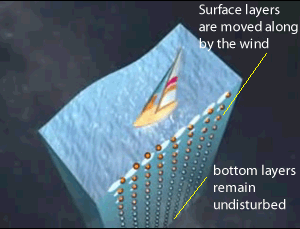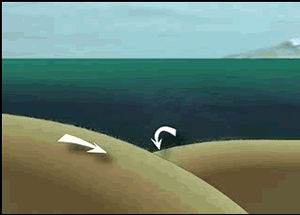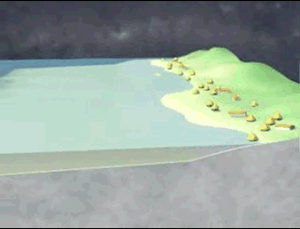Tsunamis occur when a column of water is suddenly displaced in the ocean. This can be due to an earthquake, a volcanic eruption or a less likely event of a meteorite striking the surface of the ocean.
Waves created by a tsunami differ from those created by wind. Wind generated waves involve the movement of water, close to the surface, in a circular motion which helps propagate the waves along the surface. The strength of such waves depends on their movement along the first few metres of water near the surface. Deepdown the water particles remain undisturbed.
A tsunami is generated when the entire column of water rising from the depth of the ocean is thrusted upwards.

To see what natural phenomena can generate the immense forces necessary to displace huge columns of water we must look at the surface of the earth. The surface resembles a jigsaw puzzle with up to 12 pieces, called plates. Unlike a jigsaw puzzle these plates are in constant motion, albeit very slow, about 10 cm a year. Three types of boundaries exist, transform boundaries, divergent boundaries and convergent boundaries.
Around Japan, there are four plates that meet pushing and rubbing against each other. Oceanic plates, that is plates supporting great bodies of water, are usually heavier than continental plates and tend to be dragged under continental plates. The movement of a continental plate over an oceanic plate is known as subduction. Subduction can sometimes form volcanoes and tsunamis as was the case in Sendai City, Japan, on the 11th of March 2011.
When a continental plate becomes too bent, as shown on the right, it suddenly snaps back releasing a great deal of energy. This is how a plate-boundary earthquake takes place. When this happens, a column of deep sea water is pushed up from the ocean floor. The wave that is generated, at the surface, then spreads in all directions, just like the ripples in a pond. This is a tsunami with an average speed of around 80 km per hour when the water is 50 m deep up to about 800 kph, at a depth of 5,000 m.



How does wind generate a surface wave?
How is a tsunami generated?
How does a tsunami differ from a normal wave generated by wind?
How does a tsunami change as it approaches the land?
What is subduction?
Why is it that oceanic plates sink below continental plates when they collide?
What are three ways in which plates interact with each other?